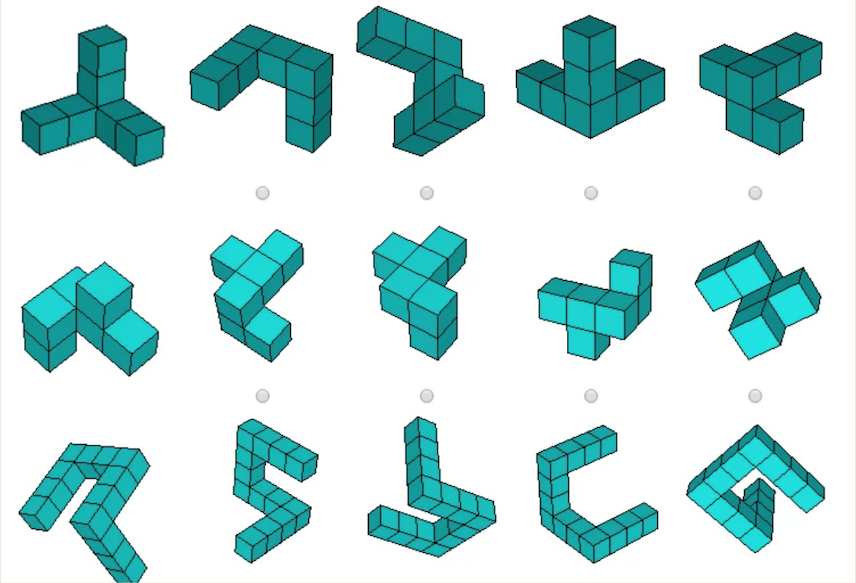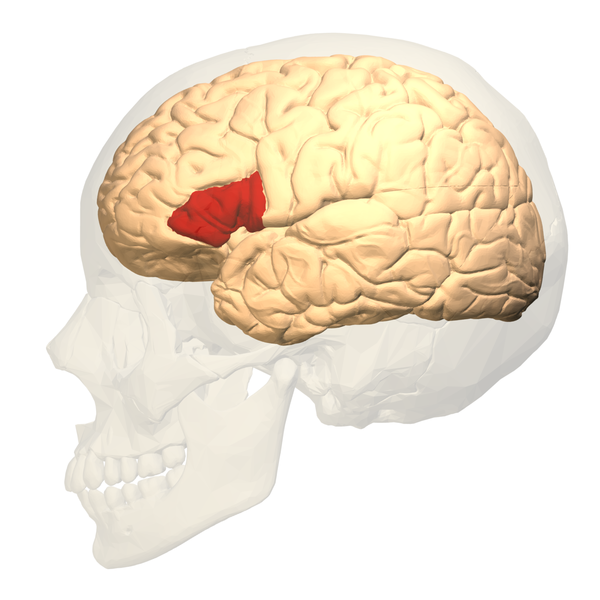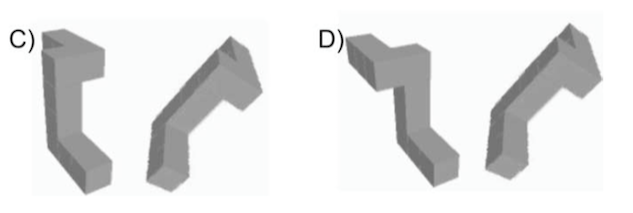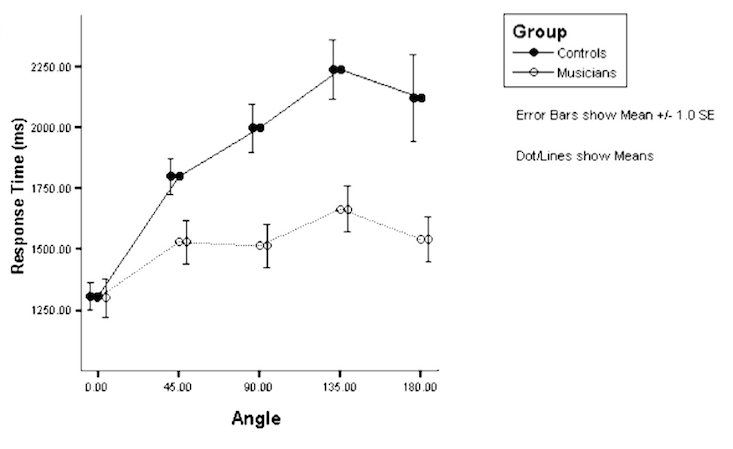Title of paper under discussion
Broca’s Area Supports Enhanced Visuospatial Cognition in Orchestral Musicians
Authors
Vanessa Sluming, Jonathan Brooks, Matthew Howard, John Joseph Downes and Neil Roberts
Journal
Journal of Neuroscience 4 April 2007, 27 (14) 3799-3806
Link to paper (free access)
Overview
In solving freshly presented 3D mental rotation puzzles, members of the Royal Liverpool Philharmonic Orchestra (RLPO) consistently demonstrated levels of skill “normally only attained after significant practice”. Magnetic Resonance Imaging (MRI) brain scanning carried out on the musicians – and some non-musicians too – whilst they tackled the puzzles, gave scientists a window into this enhanced ability. In the non-musicians’ brains it was only a brain circuit called the ‘visuospatial network’ that ‘lit up’ during solving. But in the musicians’ brains an additional region – ‘Broca’s area’ – became active, a region most commonly associated with speech but also known to support musical sight-reading and ‘motor-sequence organisation’. The researchers deduced that development of musical sight-reading skills alters a musician’s brain in a way that ‘confers a wider cognitive benefit’- in this case, an enhanced ability to solve 3D mental rotation puzzles.

Introduction
Vanessa Sluming and her colleagues, based at the University of Liverpool just down the road from the Philharmonic Hall, reasoned that the sight-reading skills of an orchestral musician, so essential to their everyday professional lives, bear striking similarities to 3D mental rotation (3DMR) skills. Sight-reading involves “the extremely rapid implementation of a series of operations through perception, including visuospatial analysis of symbolic input [reading printed music], to the sequential and coordinated motor output [of musical performance].” 3D mental rotation tasks are similar in that they involve “rapidly sequencing a series of operations”: looking at an object (A), looking at another one (B), mentally rotating B (by imagined “motor transformation”) to discover if it’s the same as A, and finally committing to the decision.
Broca’s area has been shown to be involved in “the visuospatial analysis and sequencing of rapid motor actions” necessary for sight-reading, and the longer a musician has spent in an orchestra the larger the volume of grey cells in their Broca’s area becomes.

Sluming and her team set out to test the hypothesis that musicians would therefore recruit their richly developed Broca’s area (in addition to the brain’s other visuospatial circuits) in order to solve 3D mental rotation (3DMR) puzzles, making their solving ability quicker and more accurate in the process.
Knowing that orchestral musicians tend to improve at other visuospatial tasks with age – in contrast to non-musicians whose abilities worsen – Sluming also predicted an “age-related enhancement in 3DMR by orchestral musicians”.
Though this experiment was exploring the transferability of musical sight-reading skills into 3DMR skills, the brain region under investigation – Broca’s area – is known not just for serving musical sight-reading but also (and much more famously) for speech processing, especially visual speech. Sluming was therefore also keen to investigate if speech-processing ability, and Broca’s area activation during speech-processing, was different in musicians compared with non-musicians. If so, verbal ability – as well as sight-reading ability – would have to be factored in to any conclusions drawn about musicians and 3DMR.
Method
10 male musicians, all string players from the RLPO, and 10 male non-musicians (matched in age and right-handedness) underwent two sets of tasks whilst lying in an fMRI brain scanner:
1. Assessment of verbal intellectual ability. Participants were asked to judge as rapidly as possible whether simple sentences, presented on a screen, were ‘true’ or ‘false’. The sentences reflected “everyday, common sense world knowledge that should be known to most people (eg “prime ministers are made in factories” and “prime ministers are people”).”
2. Assessment of 3DMR skills. Pairs of images (as in examples ‘C’ and ‘D’ below) were presented to participants, who were asked to judge as quickly as possible whether they were “identical (with one rotated relative to the other) or nonidentical.” The rotations were at either 0°, 45°, 90°, 135° or 180°, clockwise and counterclockwise.

Results
In the verbal intelligence assessment no significant difference was found between non-musicians and musicians in terms of accuracy or speed of answers. Both groups also showed the same pattern and level of brain activity (“mainly in the left hemisphere, notably, the classic language regions of Broca’s and Wernicke’s areas”).
In contrast, the 3DMR assessment revealed significant differences between the two groups both in terms of their speed/accuracy at solving the puzzles and their patterns of brain activity whilst solving them.
Musicians were quicker and more accurate than non-musicians. Moreover non-musicians took longer to answer when the images were rotated through larger angles (a “classic signature” of 3DMR solving) whereas musicians’ solving speed was more or less independent of the extent of the image rotation. This is depicted in the graph below (in which a high ‘response time’ is a slow solving speed, and ‘angle’ is the rotation angle between the images):

As regards the relationship between a participant’s ‘age’ and their ‘time taken to solve the puzzle’, musicians showed a negative association, meaning that the older they were (and the longer they’d been an orchestral musician) the quicker they could solve it. The results for non-musicians showed a trend in the opposite direction, tallying with the common finding that the older people take longer to solve 3DMR tasks.
The fMRI brain scans taken of musicians and non-musicians while solving the puzzles came up with some similarities and some differences between the groups. Both groups’ scans revealed increased activity in classic visuospatial networks, including visual association, premotor and superior parietal areas of the cortex. But musicians, in contrast to non-musicians, also exhibited greater activity in Broca’s area (together with the right angular gyrus and the left anterior cingulate cortex). And intriguingly the musicians who were best at solving the puzzle whatever the rotation angle were the ones with the highest activity in Broca’s area.

Discussion
Sluming and her colleagues conclude that “increased activation of Broca’s area in the musicians’ group mediates faster mental manipulation of 3DMR stimuli and greater accuracy of decision making”. Verbal processing ability (and its concomitant brain activity) – the results for which were the same across both groups – was shown to have no association with the 3DMR findings.
They note that Broca’s area is “one of the last brain regions to reach maturity in the adult brain, thus retaining a high degree of neuroplasticity during adolescence and early adulthood when musicians, who progress to achieve a professional standard of performance, will be practising their musical skills intensely”. Such a brain area, whose development has been stimulated by music practice, can then be “recruited to subserve complex visuospatial, nonmusical tasks such as 3DMR”.
The scientific argument is that the tasks of ‘musical sight-reading’ and ‘3D mental rotation’ share strong similarities, so it is not surprising that musicians recruit a highly developed “sight-reading” brain region to help them solve 3DMR puzzles, thereby enabling them to excel. In the words of the paper “organisation of the covert motor sequencing necessary for enhanced performance of 3DMR by musicians shares a neural substrate with the visuospatial sight-reading skills of musical performance”.
Coda
Elgar – Serenade for Strings, Op. 20
Royal Liverpool Philharmonic Orchestra, cond. Vasily Petrenko